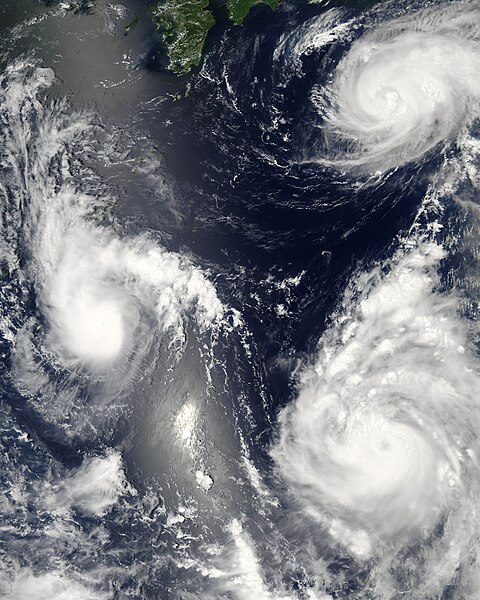Файл:Maria, Bopha and Saomai 2006-08-07 0435Z.jpg

Размер на този преглед: 480 × 600 пиксела. Други разделителни способности: 192 × 240 пиксела | 384 × 480 пиксела | 614 × 768 пиксела | 819 × 1024 пиксела | 1638 × 2048 пиксела | 7200 × 9000 пиксела.
Оригинален файл (7200 × 9000 пиксела, големина на файла: 7,6 МБ, MIME-тип: image/jpeg)
История на файла
Избирането на дата/час ще покаже как е изглеждал файлът към онзи момент.
| Дата/Час | Миникартинка | Размер | Потребител | Коментар | |
|---|---|---|---|---|---|
| текуща | 03:06, 8 август 2006 |  | 7200 × 9000 (7,6 МБ) | Good kitty | == Summary == {{Information |Description=Three different typhoons were spinning over the western Pacific Ocean on August 7, 2006, when the Moderate Resolution Imaging Spectroradiometer (MODIS) on NASA’s Aqua satellite acquired this image. The strongest |
Използване на файла
Следната страница използва следния файл:
Глобално използване на файл
Този файл се използва от следните други уикита:
- Употреба в ar.wikipedia.org
- Употреба в az.wikipedia.org
- Употреба в bh.wikipedia.org
- Употреба в crh.wikipedia.org
- Употреба в cs.wikipedia.org
- Употреба в de.wikipedia.org
- Употреба в en.wikipedia.org
- Typhoon
- Typhoon Saomai
- Tropical cyclone
- Wikipedia:Picture peer review/Archives/Archive2006
- User:Plasticup/MyFavorites
- Typhoon Maria (2006)
- User talk:Hurricanehink/Archive 23
- User talk:Thegreatdr/2012archive
- Wikipedia:Wikipedia Signpost/2013-11-20/Traffic report
- Wikipedia:Wikipedia Signpost/Single/2013-11-20
- Wikipedia:Top 25 Report/November 10 to 16, 2013
- User:Tfmbty/2006 Pacific typhoon season
- User:SongdaTalas/Archives of Former Articles
- Употреба в en.wiktionary.org
- Употреба в es.wikipedia.org
- Употреба в fi.wikipedia.org
- Употреба в hi.wikipedia.org
- Употреба в id.wiktionary.org
- Употреба в incubator.wikimedia.org
- Употреба в ja.wikipedia.org
- Употреба в ja.wikibooks.org
- Употреба в ko.wikipedia.org
- Употреба в lo.wikipedia.org
- Употреба в ms.wikipedia.org
- Употреба в my.wikipedia.org
- Употреба в nn.wikipedia.org
- Употреба в no.wikipedia.org
- Употреба в pt.wikipedia.org
- Употреба в ro.wikipedia.org
- Употреба в ru.wikipedia.org
- Употреба в szy.wikipedia.org
- Употреба в th.wikipedia.org
- Употреба в tk.wikipedia.org
- Употреба в tr.wikipedia.org
Преглед на глобалната употреба на файла.






